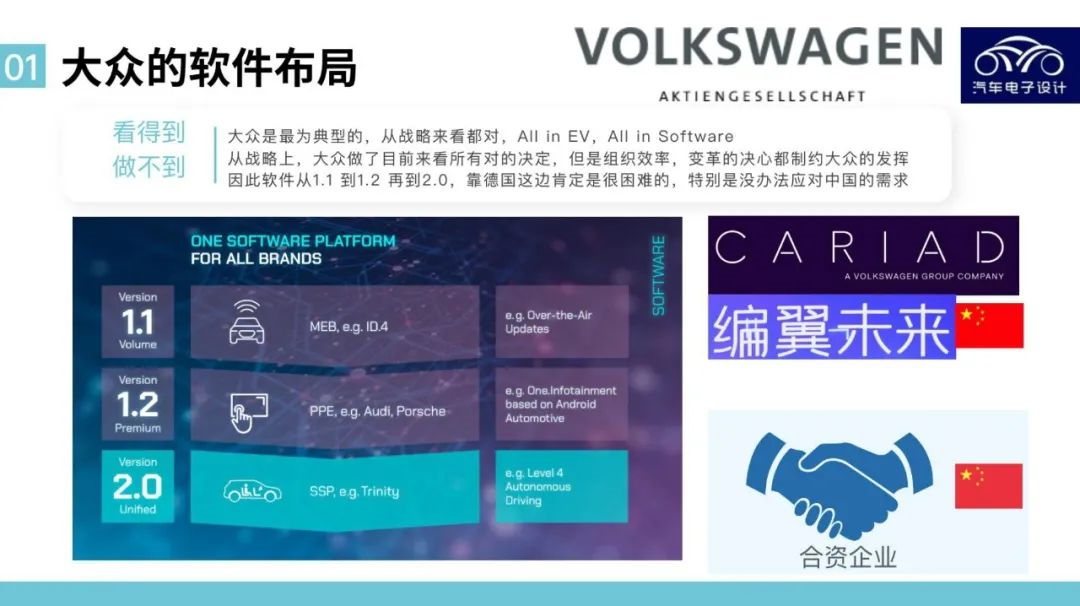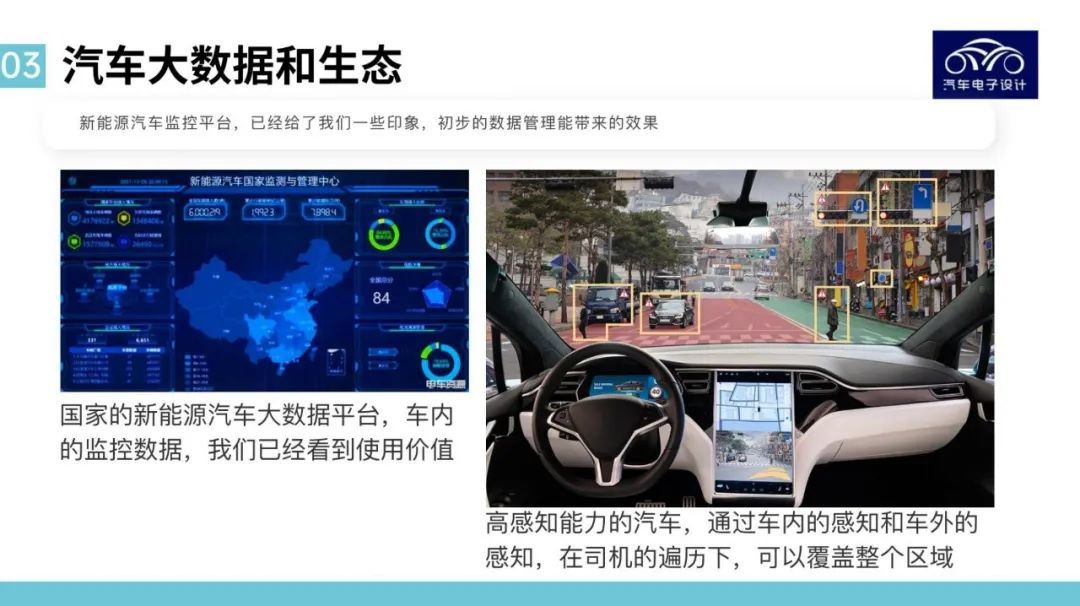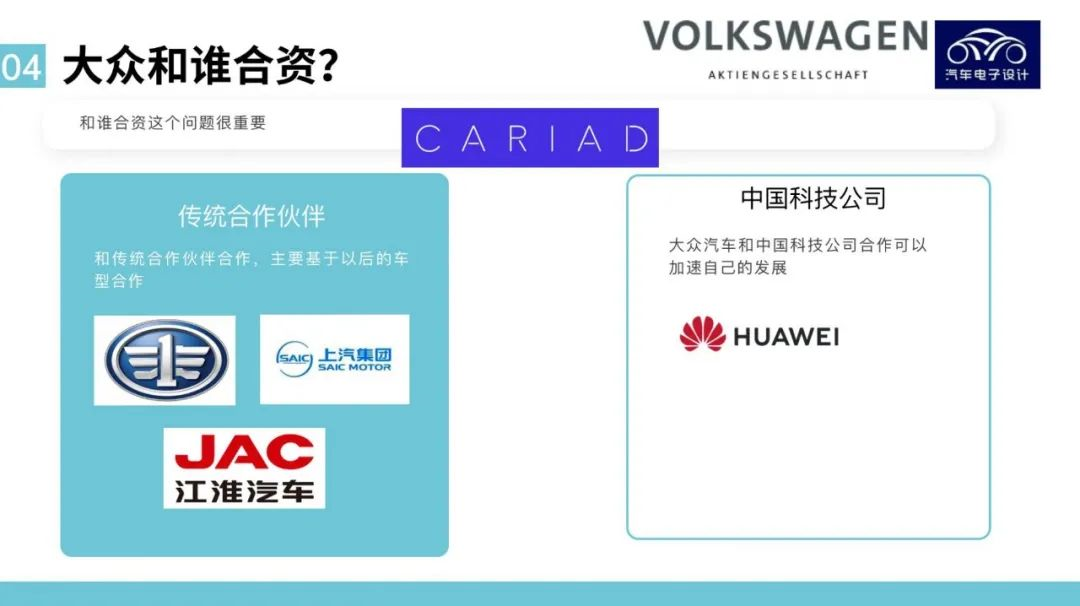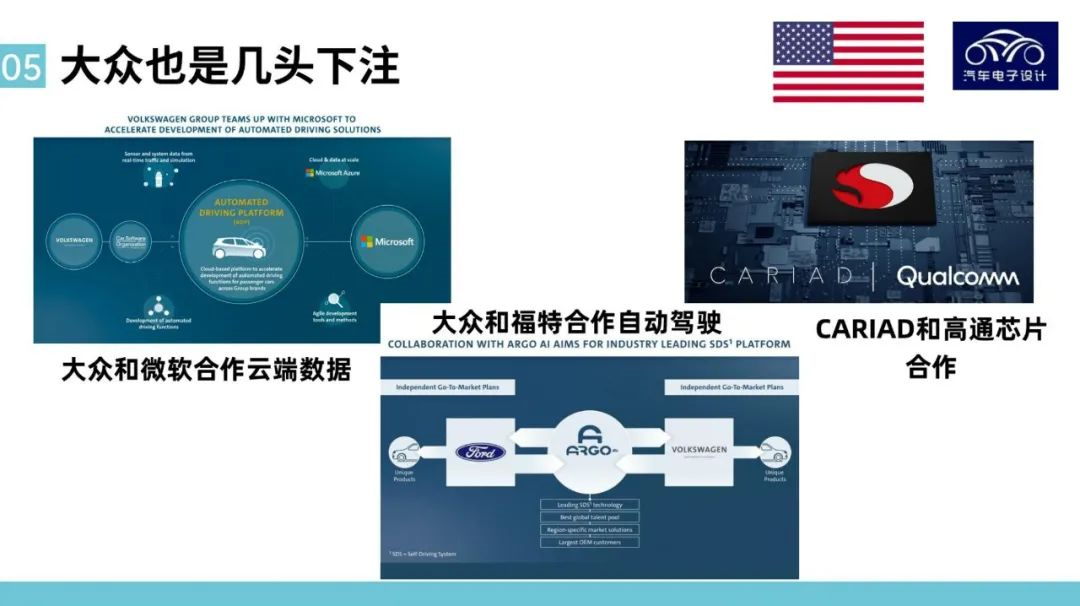Author: Zhu Yulong
Reuters reported that Volkswagen plans to invest more than 1 billion euros in a joint venture engaged in software production in China, and the company is expected to release an official statement next week. It’s interesting that Volkswagen established a Chinese software subsidiary in April 2022 and formed a Chinese team of 600 employees. Volkswagen positions China as its primary software center to serve both China and the world, which is quite clear.
At present, automotive companies are establishing joint venture software companies mainly focused on software development.
There are several possibilities here:
-
Building an ecosystem in China together with Chinese partners to invest in a supply chain that meets Chinese demand, mainly in response to the current shortage of software for ID series electric and fuel vehicles.
-
Forming a joint venture with Chinese tech companies in response to China’s local needs, such as smart driving, intelligent cockpit, and networked big data. By collaboratively enhancing Volkswagen’s capabilities in China, VW can promote its partnership with Chinese partners.
Ultimately, if Volkswagen cannot come up with effective technical solutions, the value of its cooperation with SAIC, FAW, and JAC in the future will be significantly discounted. Volkswagen is the most typical traditional automotive company that is All in EV and All in Software, strategically speaking. However, Volkswagen’s organizational efficiency and determination for transformation have restrained the company’s performance. Therefore, it is very difficult for software to progress from 1.1 to 1.2 and then to 2.0 relying solely on the German side, especially without addressing China’s needs.

Volkswagen’s Weaknesses
Currently, Volkswagen is well aware of the problems facing the development of software products for global consumers, including advanced driver assistance systems and autonomous driving (ADAS and L3 and above), next-generation intelligent interconnectivity, intelligent cockpit, big data, and software operating systems. The most crucial problem is the software ecosystem in China, the United States, Europe, and other regions, especially in intelligent driving, including perception, planning, control, high-precision maps, and cloud backend support for iterative and training of software in the car. In addition, smart cockpit includes APPs and middleware supporting APPs, as well as a cloud backend to support user demand iteration.
The development of automotive software currently revolves around the collaboration between in-car software and the cloud. The demand for automotive software requires significant investment from car companies, but the short-term output is not clear. Consumers recognize the need for advanced software but do not have a clear willingness to pay.

When it comes to in-car and cloud software, it is inevitable that a core issue cannot be overlooked, which is how data from different regions will be communicated. China, the United States, Europe, and other regions have sensitive data generated by automotive usage that cannot leave their respective regions.
-
Changing customer demand in different regions: As we see, the development of differentiated networks (similar to the directional evolution of species with geographic isolation) created a huge difference in China and the Western internet ecosystems. Currently, smart cars in smart cockpits are following the same path as smartphones. The changing demands of customers in different regions and the different internet ecosystems cause the differences in intelligent automotive software and ecosystems to continue to expand.
-
Management changes in data: The development of the software era requires both terminals and consumers to generate data, which is highly malleable. The automatic driving and cockpit features inside cars should be able to cover both in-car and external environments. Currently, China has started managing car data, and the perceptual capabilities brought by high-definition cameras can quickly collect geographical data. With the help of AI’s deep mining, it can be useful.

The question of joint ventures
In fact, this is a bet placed by several companies in China:
-
One the one hand, we should focus on cooperating with traditional car makers to stabilize partners. This work is mainly carried out by Cariad’s Chinese team. We work closely with various brands of the group and three joint venture partners in China to provide consumers with software-defined mobile travel solutions and achieve the company scale effect at the software level.
-
On the other hand, we must find technology providers to cooperate in software. According to Manager Magazin, Volkswagen is currently negotiating with Chinese company Huawei, which is likely to be a joint venture.

In the United States, Volkswagen is also a major player, pulling American technology companies into the automotive industry, with a focus on Volkswagen’s development.
-
CARIAD collaborates with Qualcomm on chip applications and customization.
-
Volkswagen partners with Microsoft to reference cloud-based data for autonomous driving.
-
Volkswagen and Ford cooperate on Argo AI for trials above L4.

Conclusion: It is unlikely to focus on software in Europe at present, and only China and the United States have such strong software capabilities. Volkswagen is likely betting on both ends, mainly relying on external forces. Traditional European car manufacturing may inevitably be marginalized with electrification and software adoption.
This article is a translation by ChatGPT of a Chinese report from 42HOW. If you have any questions about it, please email bd@42how.com.
